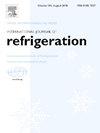r744 -烃类混合物在运输用两级制冷循环中的性能评价
IF 3.8
2区 工程技术
Q1 ENGINEERING, MECHANICAL
International Journal of Refrigeration-revue Internationale Du Froid
Pub Date : 2025-09-24
DOI:10.1016/j.ijrefrig.2025.09.024
引用次数: 0
摘要
越来越多的环境问题和法规迫使暖通空调和制冷行业转向低全球升温潜能值制冷剂。因此,研究人员正在积极探索传统氢氟碳化物系统的可持续替代品。本研究提供了用于中型冷藏车的两级蒸汽压缩循环中CO2 (R744) -碳氢化合物混合物的数值下降分析。通过在各种环境条件下模拟R744与少量(高达10%)R290, R600a, R1270和RE170的混合物,本研究确定了可以匹配或提高纯R744性能的选项。对意大利米兰和巴勒莫两个城市典型热负荷的季节模拟表明,R744与R290和R1270的混合物实现了相当或改进的季节COP (SCOP),特别是在较冷的气候条件下,系统性能受益于温度下降。92% R744和8% R290的最佳混合物在米兰和巴勒莫的SCOP分别提高了2.96%和2.13%,而R600a或RE170的混合物则降低了效率。这些研究结果表明,R744 - R290和R744 - R1270混合物是一种有前途的低全球变暖潜值冷藏运输选择。本文章由计算机程序翻译,如有差异,请以英文原文为准。
Performance evaluation of R744-hydrocarbon blends in a two-stage refrigeration cycle for transport applications
The increasing environmental concerns and regulations are forcing the HVAC&R sector to shift towards low-GWP refrigerants. Hence, research is actively exploring sustainable alternatives to traditional HFC-based systems. This study provides a numerical drop-in analysis of CO2 (R744) - hydrocarbon blends in a two-stage vapor compression cycle designed for a mid-sized refrigerated truck. By simulating blends of R744 with small amounts (up to 10 %) of R290, R600a, R1270, and RE170 under various ambient conditions, this research identifies the options that could match or enhance the performance with respect to pure R744. Seasonal simulations, accounting for typical thermal loads in two Italian cities, i.e., Milan and Palermo, reveal that R744 blends with R290 and R1270 achieve comparable or improved seasonal COP (SCOP), especially in colder climates where the system performance benefits from temperature glide. The optimal blend, 92 % R744 and 8 % R290, provides SCOP increases of 2.96 % in Milan and 2.13 % in Palermo, while blends with R600a or RE170 show reduced efficiency. These findings suggest the R744 - R290 and R744 - R1270 blends as a promising low-GWP option for refrigerated transport.
求助全文
通过发布文献求助,成功后即可免费获取论文全文。
去求助
来源期刊
CiteScore
7.30
自引率
12.80%
发文量
363
审稿时长
3.7 months
期刊介绍:
The International Journal of Refrigeration is published for the International Institute of Refrigeration (IIR) by Elsevier. It is essential reading for all those wishing to keep abreast of research and industrial news in refrigeration, air conditioning and associated fields. This is particularly important in these times of rapid introduction of alternative refrigerants and the emergence of new technology. The journal has published special issues on alternative refrigerants and novel topics in the field of boiling, condensation, heat pumps, food refrigeration, carbon dioxide, ammonia, hydrocarbons, magnetic refrigeration at room temperature, sorptive cooling, phase change materials and slurries, ejector technology, compressors, and solar cooling.
As well as original research papers the International Journal of Refrigeration also includes review articles, papers presented at IIR conferences, short reports and letters describing preliminary results and experimental details, and letters to the Editor on recent areas of discussion and controversy. Other features include forthcoming events, conference reports and book reviews.
Papers are published in either English or French with the IIR news section in both languages.

 求助内容:
求助内容: 应助结果提醒方式:
应助结果提醒方式:


